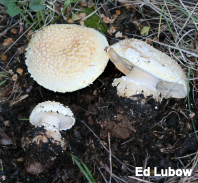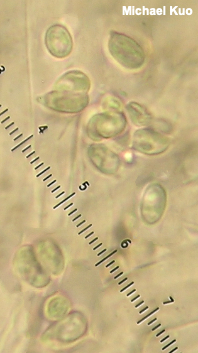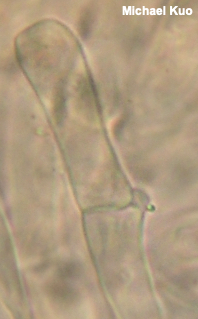| Major Groups > Gilled Mushrooms > Pale-Spored > Cercopemyces crocodilinus |

|
[ Basidiomycota > Agaricales > Tricholomataceae > Cercopemyces . . . ] Cercopemyces crocodilinus by Michael Kuo, 6 December 2024 Cercopemyces crocodilinus is a recently described, apparently rare species from western North America, reminiscent of some species of Amanita; it is a fairly large mushroom with a convex cap that is covered with scales that look very much like the warts on some Amanita species—but the "warts" cannot be easily removed from the cap surface, and are actually innate scales. The stem is also Amanita-like, with its large basal bulb, ringed with veil tissue. However, the gills of Cercopemyces crocodilinus are are not free from the stem (they are notched or narrowly attached), and its microscopic features are not very Amanita-like. In fact Cercopemyces crocodilinus is more closely related to species of Ripartitella (see Ripartitella brasiliensis) and to cystodermatoid mushrooms than to Amanita, according to its DNA (Baroni and collaborators 2014). Surprisingly, given how large and distinctive it is, Cercopemyces crocodilinus is known from only a few collections. Have you seen something that looks like it, growing under mountain mahogany? Please send me an email at ; your collection should be preserved and documented! Thanks to the Sam Mitchel Herbarium of Fungi at the Denver Botanic Gardens for facilitating my study of Cercopemyces crocodilinus, and to Ed Lubow for permission to reproduce his photo of the collection, and thanks to Allison Reynolds for documenting, collecting, and preserving Cercopemyces crocodilinus for study; her collection is deposited in The Herbarium of Michael Kuo. Description: Ecology: Possibly associated, at least sometimes, with mountain mahogany (trees in the genus Cercocarpus, including birchleaf mountain mahogany), presumably in a mycorrhizal relationship; growing gregariously; summer; originally described from Utah (Baroni et al. 2014); distributed in Rocky Mountains. The illustrated and described collections are from Colorado and Alberta. Cap: 4–10 cm across; broadly convex; dry; dull yellowish to whitish, becoming brownish with age; covered with innate scales that are larger in the center and smaller toward the margin; the margin adorned with small, overhanging, fibrillose scales, and not becoming lined at maturity. Gills: Narrowly attached to the stem, or notched; close or nearly crowded; short-gills frequent; white. Stem: 4–6 cm long; 2–3 cm thick; with a large basal bulb that takes up a third to half of the stem's length, creating a squatty stature; dry; whitish; upper edge of the bulb girdled with small white scales. Flesh: White; not changing when sliced. Odor: Not distinctive. Spore Print: Not recorded; presumably white. Microscopic Features: Spores 3.5–6 x 3–4.5 µm; ellipsoid, with a prominent apiculus; smooth; inamyloid; hyaline in KOH; walls cyanophilic in lactophenol and cotton blue. Basidia 20–25 x 4–5 µm; clavate; 2- and 4-sterigmate. Hymenial cystidia not found. Lamellar trama parallel. Pileipellis a cutis; elements 5–10 µm wide, smooth, hyaline to yellowish in KOH; with areas of inflated, exserted cells 5–15 µm wide, smooth, hyaline in KOH, with widely cylindric, subclavate, clavate, or subcapitate terminal elements. Clamp connections present. REFERENCES: T. J. Baroni, B. R. Kropp & V. S. Evenson, 2014. (Baroni et al., 2014; Cripps, Evenson & Kuo, 2016; Martínez et al., 2024.) Herb. DBG 24386. Herb. Kuo 08192401. This site contains no information about the edibility or toxicity of mushrooms. |
© MushroomExpert.Com |
|
Cite this page as: Kuo, M. (2024, December). Cercopemyces crocodilinus. Retrieved from the MushroomExpert.Com Web site: http://www.mushroomexpert.com/cercopemyces_crocodilinus.html |



